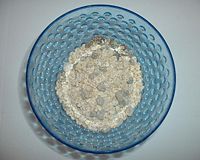Oatmeal

Oatmeal is a product of ground oat groats (i.e. oat-meal, cf. cornmeal, peasemeal, etc.) or a porridge made from this product (also called oatmeal cereal or stirabout, in Ireland). The term, 'oatmeal' can refer also to other products made from oat groats, such as cut oats, crushed oats, and rolled oats. The groats are coarsely ground to make oatmeal, or cut into small pieces to make steel-cut oats, or steamed and rolled to make rolled oats. The quick-cooking rolled oats ("quick oats") are cut into small pieces before being steamed and rolled. "Instant" oatmeal is pre-cooked and dried, usually with sweetener and flavor additives.[1] Oatmeal is used to make porridge, as an ingredient as in oatmeal cookies and oat cakes, or as an accent as in the topping on many oat bran breads and the coating on Caboc cheese. It is also used as a thickener in some foods such as canned chili con carne. Oatmeal is also used in some alcoholic drinks, cosmetics, soaps, external medical treatments, and is sometimes added to animal feed products.
Contents |
Breakfast cereal health benefits
There has been increasing interest in oatmeal in recent years due to its beneficial health effects. Daily consumption of a bowl of oatmeal can lower blood cholesterol, due to its soluble fibre content[2]. After reports found that oats can help lower cholesterol, an "oat bran craze" swept the U.S. in the late 1980s, peaking in 1989. The food fad was short-lived and faded by the early 1990s. The popularity of oatmeal and other oat products again increased after the January 1997 decision by the Food and Drug Administration that food with a lot of oat bran or rolled oats can carry a label claiming it may reduce the risk of heart disease, when combined with a low-fat diet. This is because of the beta-glucan in the oats. Rolled oats have also long been a staple of many athletes' diets, especially weight trainers; given oatmeal's high content of complex carbohydrates and water-soluble fibre which encourages slow digestion and stabilises blood-glucose levels. Despite these developments, according to the New York Times, Harry Balzar of the NPD Group stated that "the proportion of Americans who eat oatmeal for breakfast has not changed in 20 years;" "one in five Americans eats oatmeal." Oatmeal porridge also contains more B vitamins and calories than other kinds of porridges.[3] Cooked oatmeal has a lower GI value than has uncooked, because cooking releases water-soluble fibre from the grain. These fibers release glucose very slowly.
|
Cultural associations
Scotland
In Scotland, oatmeal is created by grinding oats into a coarse powder. Various grades are available depending on the thoroughness of the grinding, including Coarse, Pin(head) and Fine oatmeal. The main uses are:
- as an ingredient in baking
- in the manufacture of bannocks or oatcakes
- as a stuffing for poultry
- as a coating for Caboc cheese
- as the main ingredient of the Scottish dish, skirlie, or its chip-shop counterpart, the deep-fried thickly-battered mealy pudding
- mixed with sheep's blood, salt, and pepper to make Highland black pudding
- mixed with fat, water, onions and seasoning, and boiled in a sheep's intestine to make "marag geal"' Outer Hebridean white pudding, served sliced with fried eggs at breakfast.
- Traditional porridge (or "porage")
- Brose: a thick mixture made with uncooked oatmeal and butter or cream; eaten like porridge but much more filling.
- Rolled oats, crushed oats, and other "instant" variations are often used for this purpose nowadays, since they are quicker to prepare.
- Gruel, made by mixing oatmeal with cold water which is then strained and heated for the benefit of infants and invalids.
Oatmeal has a long history in Scottish society because oats are better suited than wheat to the short, wet growing season. Hence it became the staple grain of that country. Ancient Scottish Universities had an holiday called Meal Monday, to permit students to return to their farms and collect more oats for food.
Samuel Johnson referred, disparagingly, to this in his dictionary definition for oats: "A grain, which in England is generally given to horses, but in Scotland supports the people." His biographer, James Boswell, noted that Lord Elibank was said by Sir Walter Scott to have retorted, "Yes, and where else will you see such horses and such men?"[4]
A common alternative method of cooking oatmeal in Scotland is to soak it overnight in salted water and cook on a low heat in the morning for a few minutes until the mixture thickens.
Vermont
In the U.S. state of Vermont oatmeal making has a long tradition originating with the Scottish settlement of the state. While there are variations, most begin with heavy steel cut oats. The oats are soaked overnight in cold water, salt and maple syrup. Early the next morning, before beginning farm chores the cook will add ground nutmeg, ground cinnamon and sometimes ground ginger. The pot is placed over heat and cooks for upwards of 90 minutes, being served after the chores with cream, milk, or butter. As most contemporary Vermonters no longer have farm chores, the recipe is simplified to a briefer 10 to 30 minute cooking at a higher heat. Vermont leads the U.S. in per capita consumption of cooked oatmeal cereal.[5]
References
- ↑ Trowbridge Filippone, F. (2007) "Oatmeal Recipes and Cooking Tips" About.com
- ↑ Mayo Clinic Staff. Cholesterol: The top five foods to lower your numbers. MayoClinic.com, http://www.mayoclinic.com/health/cholesterol/CL00002.
- ↑ New Standard Encyclopedia, 1992 by Standard Educational Corporation, Chicago, Illinois; page O-8.
- ↑ The Life of Samuel Johnson, LL.D.: Including a Journal of His Tour to the Hebrides. Volume 3 by James Boswell. Publisher: Derby & Jackson, New York, 1858. Page 11.
- ↑ Maholo: Oatmeal Facts, Figures, and Sites

